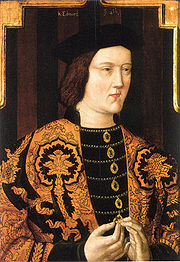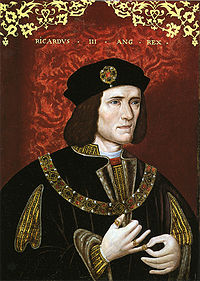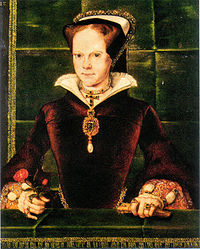
Royal Supporters of England
Encyclopedia
In heraldry
, the Royal Supporters of England are figures of living creatures appearing on each side of the Royal Arms of England. Originally, in England
, supporters were regarded as little more than mere decorative and artistic appendages. In France
, writers made a distinctive difference on the subject of supporters, giving the name of Supports to animals, real or imaginary, thus employed; while human figures or angels similarly used are called Tenants. Trees and other inanimate objects which are sometimes used are called Soutiens. Older writers trace origins of supporters to their usages in tournaments, where the shields of the combatants were exposed for inspection, and guarded by their servants or pages disguised in fanciful attire. However, medieval Scottish seals afford numerous examples in which the 13th and 14th century shields were placed between two creatures resembling lizards or dragons. Also, the seal of John, Duke of Normandy
, eldest son of the King of France
, before 1316 bears his arms as; France ancient, a bordure gules, between two lions rampant away from the shield, and an eagle with expanded wings standing above it. The Royal Supporters of the monarchs of England, displayed a variety, or even a menagerie, of real and imaginary beasts, either side of their Royal Arms of Sovereignty, including the lion, leopard, panther and tiger, the antelope and the hart, the greyhound, the boar and the bull, the falcon, cock, eagle and swan, the red and gold dragons, and of course, the current unicorn.
Heraldry
Heraldry is the profession, study, or art of creating, granting, and blazoning arms and ruling on questions of rank or protocol, as exercised by an officer of arms. Heraldry comes from Anglo-Norman herald, from the Germanic compound harja-waldaz, "army commander"...
, the Royal Supporters of England are figures of living creatures appearing on each side of the Royal Arms of England. Originally, in England
England
England is a country that is part of the United Kingdom. It shares land borders with Scotland to the north and Wales to the west; the Irish Sea is to the north west, the Celtic Sea to the south west, with the North Sea to the east and the English Channel to the south separating it from continental...
, supporters were regarded as little more than mere decorative and artistic appendages. In France
Kingdom of France
The Kingdom of France was one of the most powerful states to exist in Europe during the second millennium.It originated from the Western portion of the Frankish empire, and consolidated significant power and influence over the next thousand years. Louis XIV, also known as the Sun King, developed a...
, writers made a distinctive difference on the subject of supporters, giving the name of Supports to animals, real or imaginary, thus employed; while human figures or angels similarly used are called Tenants. Trees and other inanimate objects which are sometimes used are called Soutiens. Older writers trace origins of supporters to their usages in tournaments, where the shields of the combatants were exposed for inspection, and guarded by their servants or pages disguised in fanciful attire. However, medieval Scottish seals afford numerous examples in which the 13th and 14th century shields were placed between two creatures resembling lizards or dragons. Also, the seal of John, Duke of Normandy
John II of France
John II , called John the Good , was the King of France from 1350 until his death. He was the second sovereign of the House of Valois and is perhaps best remembered as the king who was vanquished at the Battle of Poitiers and taken as a captive to England.The son of Philip VI and Joan the Lame,...
, eldest son of the King of France
Philip VI of France
Philip VI , known as the Fortunate and of Valois, was the King of France from 1328 to his death. He was also Count of Anjou, Maine, and Valois from 1325 to 1328...
, before 1316 bears his arms as; France ancient, a bordure gules, between two lions rampant away from the shield, and an eagle with expanded wings standing above it. The Royal Supporters of the monarchs of England, displayed a variety, or even a menagerie, of real and imaginary beasts, either side of their Royal Arms of Sovereignty, including the lion, leopard, panther and tiger, the antelope and the hart, the greyhound, the boar and the bull, the falcon, cock, eagle and swan, the red and gold dragons, and of course, the current unicorn.
List of supporters and devices
| Monarch | Supporters | Badges | Motto | Royal Arms |
|---|---|---|---|---|
| House of Plantagenet (1327–1399) Royal liveries: white and red |
||||
 King Edward III Edward III of England Edward III was King of England from 1327 until his death and is noted for his military success. Restoring royal authority after the disastrous reign of his father, Edward II, Edward III went on to transform the Kingdom of England into one of the most formidable military powers in Europe... (1327–1377) |
|
St George's Cross St George's Cross is a red cross on a white background used as a symbolic reference to Saint George. The red cross on white was associated with St George from medieval times.... Fleur-de-lis The fleur-de-lis or fleur-de-lys is a stylized lily or iris that is used as a decorative design or symbol. It may be "at one and the same time, political, dynastic, artistic, emblematic, and symbolic", especially in heraldry... or White Greyhound of Richmond The White Greyhound of Richmond is one of the Queen's Beasts, a greyhound featured prominently in Royal Botanic Gardens, Kew. According to the Cambridge University Heraldic and Genealogical Society:... , collared gules edged with gold, with gilt eyelets and terret |
Dexter: Lion crowned, or Sinister: Falcon, argent |
|
.jpg) King Richard II Richard II of England Richard II was King of England, a member of the House of Plantagenet and the last of its main-line kings. He ruled from 1377 until he was deposed in 1399. Richard was a son of Edward, the Black Prince, and was born during the reign of his grandfather, Edward III... (1377–1399) |
|
St George's Cross St George's Cross is a red cross on a white background used as a symbolic reference to Saint George. The red cross on white was associated with St George from medieval times.... Fleur-de-lis The fleur-de-lis or fleur-de-lys is a stylized lily or iris that is used as a decorative design or symbol. It may be "at one and the same time, political, dynastic, artistic, emblematic, and symbolic", especially in heraldry... or |
|
|
| House of Lancaster (1399–1413) Royal liveries: white and blue |
||||
| King Henry IV Henry IV of England Henry IV was King of England and Lord of Ireland . He was the ninth King of England of the House of Plantagenet and also asserted his grandfather's claim to the title King of France. He was born at Bolingbroke Castle in Lincolnshire, hence his other name, Henry Bolingbroke... (1399–1413) |
|
St George's Cross St George's Cross is a red cross on a white background used as a symbolic reference to Saint George. The red cross on white was associated with St George from medieval times.... |
|
|
King Henry V Henry V of England Henry V was King of England from 1413 until his death at the age of 35 in 1422. He was the second monarch belonging to the House of Lancaster.... (1413–1422) |
|
St George's Cross St George's Cross is a red cross on a white background used as a symbolic reference to Saint George. The red cross on white was associated with St George from medieval times.... |
Dieu et mon droit Dieu et mon droit is the motto of the British Monarch in England. It appears on a scroll beneath the shield of the coat of arms of the United Kingdom... ('God and my right') |
|
.jpg) King Henry VI Henry VI of England Henry VI was King of England from 1422 to 1461 and again from 1470 to 1471, and disputed King of France from 1422 to 1453. Until 1437, his realm was governed by regents. Contemporaneous accounts described him as peaceful and pious, not suited for the violent dynastic civil wars, known as the Wars... (1422–1461) |
|
St George's Cross St George's Cross is a red cross on a white background used as a symbolic reference to Saint George. The red cross on white was associated with St George from medieval times.... |
|
Two Antelopes, argent |
| House of York (1413–1485) Royal liveries: murrey (dark red) and blue |
||||
 King Edward IV Edward IV of England Edward IV was King of England from 4 March 1461 until 3 October 1470, and again from 11 April 1471 until his death. He was the first Yorkist King of England... (1461–1483) |
|
St George's Cross St George's Cross is a red cross on a white background used as a symbolic reference to Saint George. The red cross on white was associated with St George from medieval times.... |
|
|
| King Edward V Edward V of England Edward V was King of England from 9 April 1483 until his deposition two months later. His reign was dominated by the influence of his uncle Richard, Duke of Gloucester, who succeeded him as Richard III... (1483) |
|
St George's Cross St George's Cross is a red cross on a white background used as a symbolic reference to Saint George. The red cross on white was associated with St George from medieval times.... |
|
|
 King Richard III Richard III of England Richard III was King of England for two years, from 1483 until his death in 1485 during the Battle of Bosworth Field. He was the last king of the House of York and the last of the Plantagenet dynasty... (1483–1485) |
|
St George's Cross St George's Cross is a red cross on a white background used as a symbolic reference to Saint George. The red cross on white was associated with St George from medieval times.... |
|
|
| House of Tudor (1485–1606) Royal liveries: white and green |
||||
King Henry VII Henry VII of England Henry VII was King of England and Lord of Ireland from his seizing the crown on 22 August 1485 until his death on 21 April 1509, as the first monarch of the House of Tudor.... (1485–1509) |
|
St George's Cross St George's Cross is a red cross on a white background used as a symbolic reference to Saint George. The red cross on white was associated with St George from medieval times.... Cadwaladr Cadwaladr ap Cadwallon was King of Gwynedd . Two devastating plagues happened during his reign, one in 664 and the other in 682, with himself a victim of the second one. Little else is known of his reign... Dun Cow The dun cow is a common motif in English folklore. "Dun" is a dull shade of brownish grey.-Dunsmore Heath:The Dun Cow of Dunsmore Heath was a savage beast slain by Guy of Warwick... of Warwick |
|
Dragon and Greyhound |
King Henry VIII Henry VIII of England Henry VIII was King of England from 21 April 1509 until his death. He was Lord, and later King, of Ireland, as well as continuing the nominal claim by the English monarchs to the Kingdom of France... (1509–1547) |
|
St George's Cross St George's Cross is a red cross on a white background used as a symbolic reference to Saint George. The red cross on white was associated with St George from medieval times.... |
|
|
King Edward VI Edward VI of England Edward VI was the King of England and Ireland from 28 January 1547 until his death. He was crowned on 20 February at the age of nine. The son of Henry VIII and Jane Seymour, Edward was the third monarch of the Tudor dynasty and England's first monarch who was raised as a Protestant... (1547–1553) |
|
St George's Cross St George's Cross is a red cross on a white background used as a symbolic reference to Saint George. The red cross on white was associated with St George from medieval times.... |
|
|
 Queen Mary I Mary I of England Mary I was queen regnant of England and Ireland from July 1553 until her death.She was the only surviving child born of the ill-fated marriage of Henry VIII and his first wife Catherine of Aragon. Her younger half-brother, Edward VI, succeeded Henry in 1547... (1553–1558) |
|
St George's Cross St George's Cross is a red cross on a white background used as a symbolic reference to Saint George. The red cross on white was associated with St George from medieval times.... |
|
|
 Queen Elizabeth I Elizabeth I of England Elizabeth I was queen regnant of England and Ireland from 17 November 1558 until her death. Sometimes called The Virgin Queen, Gloriana, or Good Queen Bess, Elizabeth was the fifth and last monarch of the Tudor dynasty... (1558–1603) |
|
St George's Cross St George's Cross is a red cross on a white background used as a symbolic reference to Saint George. The red cross on white was associated with St George from medieval times.... |
|
|
| House of Stuart (1603–1714) Royal liveries: yellow and red |
||||
King James I James I of England James VI and I was King of Scots as James VI from 24 July 1567 and King of England and Ireland as James I from the union of the English and Scottish crowns on 24 March 1603... (1603-now) |
|
St George's Cross St George's Cross is a red cross on a white background used as a symbolic reference to Saint George. The red cross on white was associated with St George from medieval times.... |
|
|
See also
- Royal Standards of England
- Royal Arms of England
- Royal coat of arms of the United KingdomRoyal coat of arms of the United KingdomThe Royal coat of arms of the United Kingdom is the official coat of arms of the British monarch, currently Queen Elizabeth II. These arms are used by the Queen in her official capacity as monarch of the United Kingdom, and are officially known as her Arms of Dominion...
- HeraldryHeraldryHeraldry is the profession, study, or art of creating, granting, and blazoning arms and ruling on questions of rank or protocol, as exercised by an officer of arms. Heraldry comes from Anglo-Norman herald, from the Germanic compound harja-waldaz, "army commander"...

